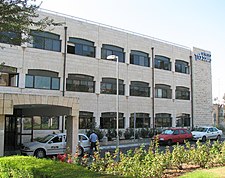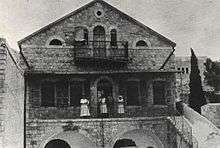Misgav Ladach
Misgav Ladach (Hebrew: מִשְׂגָּב לַדָּךְ) is a hospital in Jerusalem, Israel that belongs to Kupat Holim Meuhedet, Israel's third largest HMO.
| Misgav Ladach | |
|---|---|
| Kupat Holim Meuhedet | |
 Misgav Ladach hospital, Jerusalem | |

| |
| Geography | |
| Location | Jerusalem, Israel |
| Organisation | |
| Type | General |
| Religious affiliation | Jewish |
| History | |
| Opened | 1854 |
| Links | |
| Lists | Hospitals in Israel |
Etymology
The name of the hospital, literally "refuge for the suffering," derives from Psalms 9:10.[1]
History

Misgav Ladach hospital was established in 1854 in the Old City of Jerusalem, funded by the French Rothschild family. The hospital, founded to enable the Jews to be independent of Christian missionary hospitals,[1] served the city's Jewish population in this location until the Israeli War of Independence in 1948, when the Jordanian army conquered the Jewish Quarter.[2] The hospital reopened in Katamon in western Jerusalem, where it operated for 40 years as a maternity hospital.[1] After moving into new premises, a 6,700-sq.m., three-story building on Hizkiyahu Hamelech Street, the non-profit Sephardi organization that owned it went bankrupt.[3] The building was purchased by Kupat Holim Meuhedet, renovated and reopened in 2005.[4]
Medical innovations
Misgav Ladach method
The Misgav Ladach method for Cesarean section was developed by Michael Stark based on the Joel-Cohen incision originally introduced for hysterectomy.[5] The technique was first introduced at Misgav Ladach and is now being used in medical centers around the world. The Misgav Ladach method eliminates many conventional steps, resulting in a quicker birth, less trauma for the mother and more rapid recovery. There is less need for painkillers and antibiotics, less scarring, less bleeding and less need for anaesthesia. Risk of exposure to HIV is minimized and the speed of the operation saves operating room and staff time.[6]
Natural childbirth
In the 1980s and early 1990s, Misgav Ladach was known for its personalized approach to childbirth. The hospital was an early supporter of natural childbirth techniques and the presence of fathers in the delivery room.[7]
Medical directors
- Maccabi Salzberger
- Michael Stark[8]
See also
| Wikimedia Commons has media related to Misgav Ladakh Hospital. |
References
- Ronald L. Eisenberg (October 2006). The streets of Jerusalem: who, what, why. Devora Publishing. pp. 259–. ISBN 978-1-932687-54-5.
- James Finn; Elizabeth Anne McCaul Finn; Arnold Blumberg (January 1980). A view from Jerusalem, 1849–1858: the consular diary of James and Elizabeth Anne Finn. Fairleigh Dickinson Univ Press. pp. 180–. ISBN 978-0-8386-2271-1.
- Shapira family, partners offer $10 mln for Misgav Ladach
- Misgav Ladach operating rooms shut down
- Holmgren G, Sjöholm L, Stark M (August 1999). "The Misgav Ladach method for cesarean section: method description". Acta Obstet Gynecol Scand. 78 (7): 615–21. doi:10.1034/j.1600-0412.1999.780709.x. PMID 10422908.
- Misgav Ladach Birthing Method: A Working Visit to Vietnam and Laos
- Susan Starr Sered (2000). What makes women sick?: maternity, modesty, and militarism in Israeli society. UPNE. pp. 42–. ISBN 978-1-58465-050-8.
- Michael Stark's C-section method